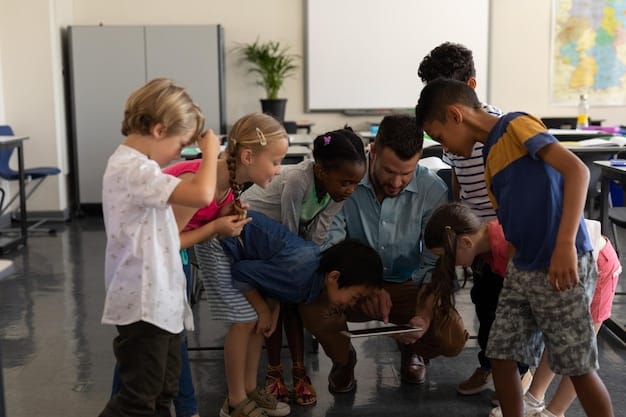IDEA Updates: How They Impact Your Child’s Education

The Individuals with Disabilities Education Act (IDEA) is periodically updated to reflect evolving best practices and legal interpretations, directly influencing how special education services are provided and how parents can advocate for their children’s educational needs.
For parents navigating the complex landscape of special education, understanding the foundational legislation is paramount. The Individuals with Disabilities Education Act (IDEA) stands as a landmark federal law ensuring that children with disabilities have access to a free appropriate public education (FAPE). However, laws are not static; they evolve, adapt, and are refined to meet contemporary needs and address emerging challenges. These updates, while sometimes subtle, can profoundly impact how special education services are delivered and, crucially, how you, as a parent, can advocate effectively for your child’s educational journey. Staying informed is not merely beneficial; it’s a critical component of ensuring your child receives the support they deserve.
Understanding the Foundation: What is IDEA?
The Individuals with Disabilities Education Act (IDEA) is a comprehensive federal law that governs how states and public agencies provide early intervention, special education, and related services to children with disabilities. It upholds the principle that all children, regardless of disability, deserve access to a public education tailored to their unique needs. Enacted originally as the Education for All Handicapped Children Act in 1975, IDEA has undergone several reauthorizations, with the most significant occurring in 1990, 1997, and 2004. Each reauthorization aimed to strengthen protections, improve outcomes, and clarify responsibilities for educators, parents, and students. The core tenets of IDEA revolve around several key principles designed to safeguard the rights of children with disabilities and their families.
Key Principles of IDEA
These guiding principles form the bedrock of special education in the United States, dictating how services are identified, planned, and implemented. Each principle is interconnected, creating a robust framework for educational equity.
* Free Appropriate Public Education (FAPE): This cornerstone principle mandates that all children with disabilities receive special education and related services that are provided at public expense, under public supervision, and without charge. The education must meet the standards of the State educational agency and include an appropriate preschool, elementary, or secondary school education. Critically, an “appropriate” education is not necessarily the best possible education, but one that is designed to provide educational benefit to the child.
* Individualized Education Program (IEP): The IEP is a written document developed for each public school child who is eligible for special education. It is essentially a blueprint for the child’s special education, detailing their present levels of performance, annual goals, special education and related services, and the extent to which the child will participate in general education. The IEP is a living document, reviewed at least annually, and is the result of a collaborative process between parents, educators, and other relevant professionals.
* Parental involvement and collaboration in the IEP process are not just encouraged but legally mandated. This ensures that parents have a voice in their child’s educational planning and that their insights into their child’s needs and strengths are considered.
* The IEP meeting is a crucial forum for discussing a child’s progress, adjusting goals, and determining appropriate services. Parents should come prepared with questions, observations, and any relevant documentation.
* For students nearing adulthood, the IEP must include a transition plan to help them prepare for post-school activities, including higher education, vocational training, employment, and independent living.
* Least Restrictive Environment (LRE): This principle emphasizes that children with disabilities must be educated with children who are not disabled to the maximum extent appropriate. Special classes, separate schooling, or other removal of children with disabilities from the regular educational environment occurs only if the nature or severity of the disability is such that education in regular classes with the use of supplementary aids and services cannot be achieved satisfactorily. This principle promotes inclusion and aims to avoid segregating students based on their disabilities.
* Appropriate Evaluation: Before a child can receive special education and related services, a full and individual evaluation must be conducted. This evaluation must be comprehensive, use a variety of assessment tools and strategies, and be administered by trained personnel. The purpose is to determine if the child has a disability and, if so, the nature and extent of the special education and related services that the child needs. Parents must provide informed consent for this initial evaluation.
* Parent and Student Participation: IDEA highlights the critical role of parents as equal participants in the educational decision-making process for their child. Parents have the right to be involved in identification, evaluation, IEP development, and placement decisions. Furthermore, as students with disabilities get older, IDEA promotes their involvement in their own educational planning and decision-making.
* Procedural Safeguards: This principle provides a safety net of legal protections for parents and children with disabilities. It includes rights such as parental consent for evaluation and placement, access to educational records, independent educational evaluations (IEEs) at public expense, prior written notice regarding changes to a child’s education, and dispute resolution options like mediation and due process hearings. These safeguards are designed to ensure that parents can effectively advocate for their child and challenge decisions they believe are not in their child’s best interest.
Understanding these foundational principles is essential for parents to effectively navigate the special education system and advocate for their child’s rights. While the core of IDEA remains constant, its interpretations and applications, particularly through policy guidance and court decisions, frequently evolve, necessitating ongoing awareness of the latest updates.
Recent Regulatory and Policy Interpretations Driving Updates
While Congress last comprehensively reauthorized IDEA in 2004, the law is far from static. Its practical application and interpretation are continually shaped by various factors, including regulatory updates from the Department of Education, significant court decisions, and guidance documents issued to clarify existing provisions. These ongoing adjustments are vital for ensuring that IDEA remains responsive to the evolving needs of students with disabilities and aligns with current educational research and legal precedents. Understanding these shifts is critical for parents and educators alike to navigate the special education landscape effectively.
The Department of Education frequently issues policy letters and guidance documents that provide clarity on how existing IDEA provisions should be interpreted and implemented. These documents, while not new legislation, carry significant weight as they reflect the official position of the federal agency responsible for overseeing IDEA.
Key Areas of Recent Interpretations:
* Least Restrictive Environment (LRE) and Inclusion: There’s a renewed emphasis on the presumption that children with disabilities should be educated in the least restrictive environment. Recent guidance often reinforces that removal from the general education setting should only occur when the nature or severity of the disability is such that education in regular classes with supplementary aids and services cannot be achieved satisfactorily. This translates into greater advocacy for inclusive practices and the provision of adequate supports within mainstream classrooms.
* This focus encourages schools to explore all possible supplementary aids and services within the general education setting before considering more restrictive placements.
* Parents are increasingly empowered to challenge placements that do not prioritize inclusion.
* Districts are encouraged to provide robust professional development for general education teachers to support diverse learners.
* Meeting the Needs of Students with Significant Cognitive Disabilities: Guidance has clarified expectations for providing challenging academic content to students with significant cognitive disabilities. This includes ensuring they have access to grade-level content standards, even if modified through alternative assessments. The aim is to raise expectations and promote higher achievement for all students.
* Discipline of Students with Disabilities: This remains a sensitive area, and recent guidance has reinforced schools’ obligations to adhere strictly to IDEA’s disciplinary provisions. This includes conducting manifestation determination reviews (MDRs) when a student with a disability faces disciplinary action that could result in a change of placement. The guidance emphasizes that disciplinary actions should be constructive and not simply punitive, aiming to address the underlying behavioral needs. For instance, if a student’s behavior is a manifestation of their disability, schools must provide functional behavioral assessments (FBAs) and positive behavior intervention plans (PBIPs).
* Parents should be aware of their rights during disciplinary proceedings, including the right to an MDR and the child’s right to continued educational services during periods of suspension or expulsion.
* The goal is to provide interventions that teach appropriate behaviors, rather than merely punishing challenging ones.
Significant court cases, particularly at the Supreme Court level, also profoundly influence IDEA’s interpretation. While less frequent, these rulings set precedents that all lower courts and educational agencies must follow. One notable example is the 2017 Supreme Court decision in Endrew F. v. Douglas County School District. This case elevated the standard for FAPE. Previously, some courts interpreted FAPE to mean merely providing “de minimis” or minimal educational benefit.
The Endrew F. decision clarified that an IEP must be “reasonably calculated to enable a child to make progress appropriate in light of the child’s circumstances.” This higher standard demands that schools offer an IEP designed to enable meaningful progress and not just trivial advancement. This ruling has empowered parents to advocate for more ambitious goals and more intensive services for their children, pushing schools to provide genuinely appropriate educational blueprints.
In addition to federal interpretations, individual states and local education agencies (LEAs) frequently issue their own policies, regulations, and guidance that further elaborate on IDEA’s implementation within their jurisdictions. These state-level updates often reflect local priorities, specific educational challenges, or unique interpretations of federal mandates. While they must always comply with federal IDEA requirements, state policies can define specific procedures, timelines, or service delivery models. Parents should be aware of both federal and state-level guidance to fully understand their rights and obligations. Remaining informed about these layered legal and policy interpretations empowers parents to ensure their child’s educational supports are truly appropriate and effective.
The Direct Impact on Your Child’s Education
The changes and clarifications within IDEA, whether from policy guidance or landmark court rulings, translate directly into the educational experiences of children with disabilities. For parents, understanding these practical implications is key to effective advocacy and ensuring their child receives the most appropriate and beneficial services outlined under the law. These updates often aim to refine the quality of education, enhance parental involvement, and strengthen protections for students.
Enhanced Standard for Educational Benefit: The Endrew F. Supreme Court decision had perhaps one of the most profound direct impacts. By raising the bar for “free appropriate public education” (FAPE) from “de minimis” benefit to “meaningful progress appropriate in light of the child’s circumstances,” schools are now legally obligated to provide IEPs that are more ambitious and challenging. This means that:
* More Ambitious IEP Goals: Parents can and should advocate for IEP goals that are genuinely challenging and designed to facilitate substantial academic and functional progress. The focus shifts from merely accessing education to actively progressing within it. Goals should not just maintain current levels of performance, but push for growth.
* Richer and More Intensive Services: To meet these more ambitious goals, schools may need to provide more intensive or specialized services, interventions, or accommodations. This could include increased therapy minutes, more specialized instruction, or access to assistive technology. The “appropriate” service is now defined by its ability to facilitate meaningful progress.
* Data-Driven Progress Monitoring: There’s an increased emphasis on collecting and analyzing data to demonstrate that the child is indeed making meaningful progress toward their IEP goals. Parents have a right to request and review this data to ensure the services are effective.
Increased Emphasis on Least Restrictive Environment (LRE) and Inclusion: Recent guidance constantly reaffirms the preference for educating students with disabilities alongside their non-disabled peers in general education settings with appropriate supports. This strengthened emphasis impacts your child in several ways:
* Greater Push for Inclusive Placements: School districts are increasingly expected to justify any decision to remove a child from the general education classroom, demonstrating that supplementary aids and services within that setting were considered and deemed insufficient.
* Necessity of Supplementary Aids and Services: The discussion around LRE now heavily revolves around what supplementary aids and services – such as paraprofessional support, specialized curriculum materials, assistive technology, or co-teaching models – can enable a child to succeed in a general education environment. Parents should actively participate in identifying and recommending such supports.
* Focus on Social-Emotional Learning within Inclusion: Beyond academics, inclusive environments foster crucial social-emotional development. This emphasis means schools are more accountable for providing opportunities for children with disabilities to interact and build relationships with their non-disabled peers, fostering a sense of belonging.
Refined Approaches to Behavior and Discipline: While the core disciplinary protections under IDEA remain, recent interpretations clarify and reinforce their application, particularly focusing on preventing behavioral challenges through preemptive strategies:
* Proactive Behavioral Supports: There’s a stronger lean towards conducting Functional Behavioral Assessments (FBAs) and developing Positive Behavior Intervention Plans (PBIPs) even before a student’s behavior escalates to the point of disciplinary action. This proactive approach aims to understand the function of challenging behaviors and teach replacement behaviors.
* Manifestation Determination Review (MDR) Clarity: Guidance has reiterated the importance of thoroughly conducting MDRs when considering a change in placement due to disciplinary infractions. The review must genuinely determine if the behavior was caused by or had a direct and substantial relationship to the child’s disability, or if the school’s failure to implement the IEP was the cause.
* Continued Educational Services: Even when a student is removed from their current placement for disciplinary reasons (e.g., in an interim alternative educational setting), the school is still obligated to provide services that enable the child to continue to participate in the general education curriculum and progress toward their IEP goals.
These evolving interpretations and court outcomes collectively shape the expectation for quality, inclusivity, and individualized support in special education. For parents, staying abreast of these changes empowers them to advocate for truly transformative educational experiences for their children.
Parental Rights and Responsibilities in Light of Updates
As the landscape of special education evolves with new interpretations and guidance under IDEA, the roles and responsibilities of parents become even more pivotal. IDEA fundamentally recognizes parents as equal partners in the educational process of their children with disabilities. This partnership requires active engagement and informed advocacy, especially as the nuances of the law are refined. Understanding your rights and responsibilities is not just about compliance; it’s about empowering you to be the most effective advocate for your child.
Strengthened Participatory Rights: Recent clarifications reinforce the parent’s central role in all stages of the special education process, from identification to placement.
* Active Role in Evaluation: Parents have the right to be fully involved in the evaluation process. This includes providing critical input on the child’s needs and strengths, reviewing evaluation results, and understanding how those results inform eligibility determination and service planning. Parents can also request an Independent Educational Evaluation (IEE) at public expense if they disagree with the school’s evaluation.
* Meaningful Participation in IEP Team Meetings: Beyond just attending, parents have the right to contribute meaningfully to the IEP development. This means coming prepared, asking questions, sharing insights about their child’s learning style, preferences, and progress at home, and ensuring their concerns are fully documented. The “meaningful progress” standard from Endrew F. particularly highlights the importance of parental input in setting ambitious and appropriate goals.
* Consent and Prior Written Notice: Parents must give informed consent for initial evaluations and for the initial provision of special education services. Furthermore, schools must provide parents with “prior written notice” whenever they propose or refuse to initiate or change the identification, evaluation, or educational placement of your child, or the provision of FAPE. This notice must explain why the school is proposing or refusing the action, and provide a full explanation of parental procedural safeguards.
Responsibilities for Effective Advocacy: With reinforced rights come responsibilities for parents to engage effectively with the school system.
* Stay Informed and Educated: Parents have a responsibility to understand IDEA, state-specific special education laws, and any new guidance or significant court decisions. Attending workshops, reading official guidance, or consulting with parent advocacy groups can significantly enhance your knowledge base. Knowledge is power in advocacy.
* Maintain Detailed Records: Keep a well-organized file of all communications with the school, including emails, meeting notes, IEP documents, evaluation reports, and progress reports. Dated records are crucial if disputes arise. Documenting interactions helps ensure continuity and provides a factual basis for any discussions or disagreements.
* Communicate Respectfully and Clearly: While advocacy can be challenging, maintaining open, professional, and clear lines of communication with school staff is paramount. Express concerns and suggestions constructively and in writing when necessary.
* Be Prepared for Meetings: Before any IEP meeting or significant discussion, review relevant documents, jot down questions, and identify key points you wish to discuss. Prioritize your concerns and be ready to provide examples or data to support your positions.
* Seek Support and Collaboration: Don’t hesitate to seek support from parent training and information centers (PTIs), disability advocacy organizations, or educational advocates. These resources can offer invaluable guidance, support, and even direct assistance in navigating complex situations. Collaboration with school staff, whenever possible, often yields the best outcomes for the child, but parents should also be ready to assert their rights when necessary.
Navigating the updated special education landscape requires parents to be proactive, informed, and engaged. By understanding their reinforced rights and embracing their responsibilities, parents can powerfully advocate for their child’s educational success and ensure that the spirit and letter of IDEA are upheld.
Navigating the IEP Process with Current Insights
The Individualized Education Program (IEP) remains the cornerstone of special education for children with disabilities. However, applying the latest IDEA updates requires a more nuanced approach to the IEP process itself. For parents, navigating this process effectively means leveraging recent interpretations to advocate for a truly appropriate and meaningful educational plan. It’s about moving beyond compliance and pushing for an IEP that reflects the highest standards of educational benefit.
The Endrew F. decision, with its emphasis on “meaningful progress appropriate in light of the child’s circumstances,” directly influences how IEP goals should be conceived and written.
* Setting Ambitious and Achievable Goals: Parents should push for goals that are challenging yet attainable, fostering genuine academic and functional growth. Goals should not just be incremental, but reflective of the child’s potential.
* Ensure goals are SMART: Specific, Measurable, Achievable, Relevant, and Time-bound.
* Goals should address all areas of need identified in the evaluation, including academics, social-emotional development, communication, and daily living skills.
* Discussion should focus on what it truly means for your child to make progress in their specific areas of need.
* Data-Driven Goal Setting and Progress Monitoring: There’s a greater imperative for the IEP team to use real data to inform goal setting and to track progress. Parents should expect to discuss baseline data for each goal and how progress will be measured consistently. If progress is not being made, the team must analyze why and adjust services or approaches.
* Relating Goals to General Education Curriculum: Even for students with significant disabilities, IEP goals should, where appropriate, be linked to the general education curriculum and grade-level content standards. This ensures that the child has access to and progress in the same curriculum as their non-disabled peers, even if highly modified.
The LRE principle, bolstered by recent guidance, pushes for greater creativity and commitment to inclusion. The IEP meeting is the forum where these decisions are made.
* Presumption of Inclusion: The team should start with the assumption that the child will be educated in the general education classroom, with supplementary aids and services, before considering more restrictive environments.
* Developing Robust Supplementary Aids and Services: Parents should actively propose and evaluate a range of supports, accommodations, and modifications that can enable their child to succeed in a general education setting. This might include:
* Assistive technology (e.g., text-to-speech software, communication devices)
* Curriculum modifications and differentiated instruction.
* Paraprofessional support (e.g., one-on-one aide, classroom aide).
* Consultation services for general education teachers from special education staff.
* Visual schedules, sensory tools, or preferential seating.
* Co-teaching models where special education and general education teachers collaborate in the classroom.
* Justification for Removal: If removal from the general education setting is considered, the IEP team must provide clear, data-based justification, demonstrating that even with extensive supplementary aids and services, the child cannot achieve satisfactory education in the general classroom. The IEP must detail the extent to which the child will *not* participate with non-disabled children and why.
For students nearing adulthood, the transition services component of the IEP becomes critical from age 16 (or earlier, if appropriate). Recent updates reinforce the importance of these services being person-centered and outcome-oriented.
* Student-Led Planning: Students, particularly older ones, should be actively involved in their transition planning. Their preferences, interests, and strengths should guide the development of post-secondary goals.
* Comprehensive Post-Secondary Goals: The IEP should include measurable post-secondary goals related to education, employment, and, where appropriate, independent living skills. These goals should be based on age-appropriate transition assessments.
* Coordinated Services: The IEP should identify specific transition services, including instruction, related services, community experiences, development of employment and other post-school adult living objectives, and, if appropriate, acquisition of daily living skills and functional vocational evaluation. This may also involve linking the student and family to external agencies that can provide adult services.
Navigating the IEP process with these updated insights means a more engaged, data-driven, and ambitious approach, ultimately aiming to equip children with disabilities for greater success in school and beyond.
Addressing Challenges and Accessing Resources
Even with the clearest legislative framework and the most well-intentioned updates, challenges in the implementation of IDEA are inevitable. Parents often encounter hurdles ranging from disagreements over IEP content to accessing appropriate services or understanding complex procedural safeguards. Fortunately, a robust ecosystem of resources exists to support parents in advocating for their children and navigating these complexities effectively.
Common challenges often stem from differing interpretations of “appropriate” education or resource limitations within school districts.
* Disagreements over IEP Content: Parents and schools may disagree on a child’s eligibility, the goals set in the IEP, the services required, or the placement. This is perhaps the most common challenge. Schools may propose services or placements that parents feel are insufficient, or parents may advocate for more intensive support than the school believes is necessary.
* Lack of Adequate Services or Resources: While IDEA mandates FAPE, schools sometimes struggle with providing specific highly specialized services due to funding constraints, lack of trained personnel, or limited program options. This can manifest as a shortage of particular therapists (e.g., occupational therapy, physical therapy, speech-language pathology), limited access to assistive technology, or a lack of appropriate inclusive classroom settings.
* Procedural Violations: Schools, sometimes unintentionally, may violate procedural safeguards, such as failing to provide timely notice, not holding IEP meetings within required timelines, or neglecting to obtain proper parental consent. These procedural missteps, if significant, can impact a child’s right to FAPE.
* Communication Breakdowns: Misunderstandings, lack of clear communication, or strained relationships between parents and school staff can hinder effective collaboration and problem-solving. This often perpetuates disagreements and makes dispute resolution more difficult.
* Transition Planning Gaps: For older students, ensuring effective transition from school to post-secondary life can be challenging. Coordinating with adult service agencies, developing realistic vocational goals, and addressing independent living skills requires significant planning and collaboration, which can sometimes be overlooked or inadequately addressed.
When challenges arise, it’s crucial for parents to know where to turn for support and guidance. Several avenues are available to help resolve disputes and ensure children’s rights are protected.
* Parent Training and Information Centers (PTIs): Funded by the U.S. Department of Education, every state has at least one PTI. These centers provide free information, training, and support to parents of children with disabilities. They can help parents understand IDEA, their rights, and how to advocate effectively for their child. They often offer workshops, one-on-one assistance, and resources tailored to specific disabilities.
* Disability Advocacy Organizations: Numerous national and local organizations focus on specific disabilities (e.g., Autism Speaks, National Down Syndrome Society, Learning Disabilities Association of America) or broader disability rights. These groups often have legal resources, advocacy toolkits, and support networks for parents.
* Mediation: IDEA requires states to offer mediation as a voluntary option for resolving disputes between parents and schools. A neutral, third-party mediator helps both sides reach a mutually agreeable solution. Mediation is often a less adversarial and more cost-effective alternative to due process hearings.
* State Complaint Process: Parents can file a formal complaint with their State Department of Education if they believe the school district has violated IDEA. The state agency will investigate the complaint and issue a finding.
* Due Process Hearings: This is a formal legal proceeding where an impartial hearing officer listens to evidence presented by both parents and the school and then issues a legally binding decision. While more adversarial, it is an important safeguard for parents if other dispute resolution methods fail.
* Educational Advocates and Attorneys: Parents can choose to hire independent educational advocates or attorneys specializing in special education law. These professionals can provide expert guidance, represent parents in meetings or hearings, and help navigate complex legal issues. While they involve a cost, their expertise can be invaluable in challenging situations.
Proactive engagement, comprehensive documentation, and knowing when and where to seek external support are vital for parents encountering difficulties. The network of resources available is designed to empower parents, ensuring that every child with a disability receives the appropriate education they are entitled to under IDEA.
Future Outlook and Emerging Trends in Special Education Law
The landscape of special education, guided by IDEA, is dynamic, constantly evolving to meet the changing needs of students with disabilities and reflect advancements in educational practice and disability rights. While the core principles of IDEA remain steadfast, future outlooks suggest continued refinement, driven by technological innovations, a deeper understanding of diverse learning needs, and societal shifts. Parents should be aware of these emerging trends as they may influence future policy and practice, further impacting their child’s educational journey.
Leveraging Technology for Personalized Learning: The rapid advancements in educational technology (EdTech) are increasingly recognized for their potential to revolutionize how special education services are delivered. Future updates and interpretations may lean heavily into:
* Adaptive Learning Platforms: These platforms can tailor content and pace to individual student needs, providing truly personalized learning experiences. Their integration into IEP plans could become more explicit, offering targeted remediation and enrichment.
* Assistive Technology (AT) Integration: Expect clearer guidance and potentially stronger mandates for the provision and funding of a wider range of AT, from sophisticated communication devices to tools that support executive function or sensory regulation. The focus will be on how AT can break down barriers to access the general curriculum and promote independent learning.
* Tele-therapy and Virtual Learning: The experiences gained during recent global events highlighted the potential and challenges of remote service delivery. Future policies might set clearer standards and guidelines for tele-therapy (e.g., speech-language pathology, mental health counseling) and virtual learning models in special education, ensuring equity and effectiveness.
Holistic Approaches and Mental Health Supports: There’s a growing recognition of the interconnectedness of academic, social-emotional, and mental health needs for students with disabilities. Future trends will likely emphasize more comprehensive, integrated support systems:
* Increased Focus on Social-Emotional Learning (SEL): IEPs may increasingly incorporate explicit goals and services related to SEL, recognizing that emotional regulation, social skills, and self-awareness are critical for academic success and overall well-being.
* Integrated Mental Health Services: Schools are becoming vital providers of mental health support. Future policies may push for more robust, in-school mental health services for students with disabilities, explicitly linking them to FAPE and ensuring coordination with external providers when necessary.
* Trauma-Informed Practices: There’s a growing understanding of how adverse childhood experiences (ACEs) and trauma can impact learning and behavior. Expect a greater emphasis on training school staff in trauma-informed approaches, creating more supportive and understanding environments for all students, including those with disabilities.
Enhanced Transition and Post-Secondary Outcomes: As the focus on meaningful progress extends beyond the K-12 setting, there will likely be greater emphasis on preparing students for successful adult lives.
* Stronger Linkages to Workforce Development: Collaboration between schools and vocational rehabilitation agencies, community colleges, and employers may become even more formalized, ensuring students with disabilities have clear pathways to meaningful employment and career development.
* Person-Centered Planning from an Earlier Age: The principle of person-centered planning, where the student’s voice and vision lead the transition process, may be applied more consistently and at earlier ages, fostering greater self-determination.
* Addressing Disparities and Equitable Outcomes: Ongoing efforts to address racial, ethnic, and socioeconomic disparities in special education identification, placement, and outcomes will continue. Future initiatives will likely focus on culturally responsive evaluations and interventions to ensure all students receive equitable services.
These emerging trends highlight a future where special education under IDEA becomes even more individualized, technologically advanced, and holistically focused on preparing students with disabilities for fulfilling lives. Staying informed about these developments will be crucial for parents and advocates to shape the future of special education and ensure their children benefit from the latest advancements and best practices.
| Key Point | Brief Description |
|---|---|
| 📚 FAPE Enhancement | The “meaningful progress” standard requires schools to provide more ambitious IEPs, ensuring substantial educational benefit. |
| 🤝 Inclusion Focus | Stronger emphasis on LRE mandates educating children with disabilities alongside peers in general education with supports. |
| ⚖️ Parental Empowerment | Reinforced parental rights mean active participation in IEPs, evaluations, and dispute resolution processes. |
| 💡 Tech Integration | Emerging trends point to increased use of adaptive learning and assistive technologies in special education. |

Frequently Asked Questions About IDEA Updates
The “meaningful progress” standard comes from the 2017 Supreme Court decision in Endrew F. It clarifies that an IEP must be reasonably calculated to enable a child to make progress appropriate in light of the child’s circumstances, no longer just “de minimus” or minimal progress. This means IEP goals should be more ambitious and challenging to ensure substantial educational benefit.
Recent IDEA interpretations place a stronger emphasis on the Least Restrictive Environment (LRE) principle. This means schools are increasingly expected to educate children with disabilities alongside their non-disabled peers in general education classrooms, with appropriate supplementary aids and services. Any removal from the general education setting must be justified by strong evidence that supports and services within that environment are insufficient.
Recent guidance for disciplining students with disabilities reinforces strict adherence to IDEA’s procedural safeguards, particularly manifestation determination reviews (MDRs). There’s an increased focus on proactive behavioral interventions, like Functional Behavioral Assessments (FBAs) and Positive Behavior Intervention Plans (PBIPs), to address underlying behavioral needs rather than simply punishing challenging behaviors.
Your role as a parent is reinforced as an equal participant in your child’s education. You have the right to active involvement in evaluations, IEP development, and placement decisions. Staying informed, maintaining clear communication with the school, and keeping detailed records are crucial responsibilities for effective advocacy under the updated guidelines.
You can access resources through Parent Training and Information Centers (PTIs), disability advocacy organizations, and your State Department of Education. These resources provide free information, training, and support to help you understand IDEA, your rights, and how to effectively advocate for your child’s special education needs.

Conclusion
Navigating the complexities of the Individuals with Disabilities Education Act can feel overwhelming for parents, yet understanding its nuances, particularly its ongoing updates, is fundamental to ensuring your child receives a truly appropriate education. The law is a living document, continually shaped by policy interpretations and landmark court decisions, all designed to refine and enhance the support systems for children with disabilities. From the elevated standards for “meaningful progress” to the reinforced emphasis on inclusive environments and proactive behavioral strategies, these evolving aspects of IDEA empower parents to advocate for more ambitious goals and more specialized services within their child’s Individualized Education Program. By staying informed, actively participating in decision-making processes, and leveraging available resources, parents are not just spectators but crucial architects of their child’s educational success, ensuring that the spirit of equity and opportunity at the heart of IDEA is fully realized.





